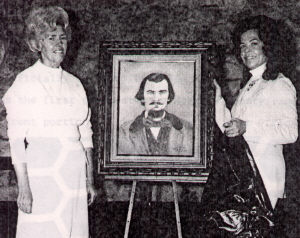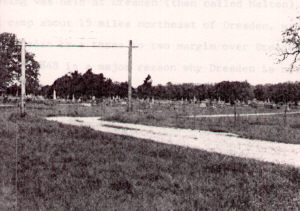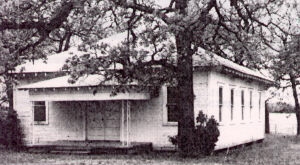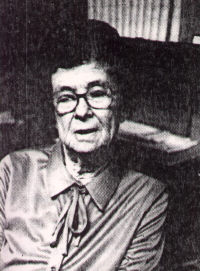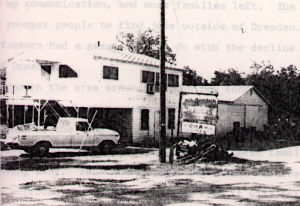The Geological Effects on the History of |
|
Michael J. Steiger Geology A.T. - May 1, 1980 Originally published in "The Navarro County Scroll", Vol. XXI 1981 Reprinted with permission of the Navarro County Historical Society The town of Dresden is situated in the southwest portion of Navarro County, about fifteen miles from Corsicana. It begins on the crossroads of Highway 55 and Highway 744, and runs along Highway 744 for about one half mile. Carol Creek and Post Oak Creek combine to flow about one mile southwest of Dresden, and Melton Creek flows about one mile northeast of the community. Lake Navarro Mills is about five miles southwest of Dresden. The land referred to in this project as the "Dresden area" encompasses up to about five miles outside the town. The purpose of this project is to link the geological factors of the land surrounding Dresden to the history of the town. As it stands today, Dresden appears to be a small community which never played a part in the county's history. This assumption is not true, and this project will show just how important Dresden was in the organization of the county. Because information dealing with the town is scarce, most of the information gathered comes from individual interviews and personal observation. The soils, grasses, trees, and topography were observed to see how they affected the town's history. Although Dresden is seldom written of, there are some materials which contain information on the town. There are books dealing with the history of Navarro County, maps which show the relationship of Dresden to other towns, and individual recollections which help tie the history together. The latter of these three, individual recollections, is the most useful in fulfilling the purpose of this project. I would like to thank Mr. Wendell Putman and his wife Wyvonne for their help in explaining the features of the land, as well as its history. I would also like to thank Mrs. Eva Putman for her detailed account of the countryside's history. THE GEOLOGICAL EFFECTS ON THE HISTORY OF DRESDEN, TEXAS, AND ITS SURROUNDING AREA. When Ethan Melton, the founder of Dresden, was traveling through Franklin County, he came across a land area which was so beautiful and productive that he decided to settle there and live out the rest of his life. The land was relatively flat with gentle, rolling hills. Trees were abundant, and the area not covered by trees contained high green grass. Wildlife thrived in this region and soils were rich. The native grass of this land is Bermuda and clover. Cattlemen today, however, sow vech and rye grass to build the soil. The wildlife that caught Melton's eye were the buffalo, deer, wild turkey, and fish. All of these would provide good food to settlers coming in to the area, and their abundance made the countryside much more appealing. The soil was a combination of sand and yellow clay. It was rich in nutrients, and Melton realized that if the land was cleared it would yield a bountiful harvest. Because the soil has been used for so long, much of it no longer contains its original amount of nutrients. Most landowners today fertilize the ground to put the nutrients back into the soil. The native trees to the land were oak, pecan, and walnut. Some fruit trees containing peaches and pears were also common. Today, there are pecan orchards a few miles from Dresden, and more peach and pear trees have been brought in to yield those fruit. In short, the land's beauty and productivity were the reasons why Melton decided to settle there. Thus, Dresden's history began. Ethan Melton founded the town of Dresden in 1943 under the name of "Spanky". Melton's brother, killed in the Alamo, received a land grant around Franklin, so Ethan came on foot from Houston to take control of his brother's land. Ethan, however, loved the land where Dresden now stands, so he got his new land transferred to the Dresden area. Mrs. Wyvonne Putman, Executive Secretary of Navarro County Historical Society, says that Melton really loved the land.
Soon after coming to this area of Texas, Melton married Mrs. Lucinda Hill, widow of Allen J. Hill, brother of Dr. George Washington Hill. Dr. Hill had been commissioned by Sam Houston in 1838 to establish an Indian trading post. That post soon became known as Spring Hill, the oldest town in Navarro County. (Dresden is the second oldest). Melton's new wife, a wealthy widow with two children, died after two years of marriage. Although she had requested that the Hills be administrators over her land, Melton got that changed and became a wealthy man. He soon remarried. At this time, Robertson County was a huge county covering a vast area in Texas, including Dresden. The people of the Dresden area wanted to form a new county because Franklin, the county seat of Robertson County, was a hundred miles away. Soon after, Navarro County was formed. On May 22, 1846, a regular Post Office was established at Dresden. The town's name was officially changed from "Spanky" to "Melton". Ethan Melton was the first postmaster in Navarro County and he used the front portion of his house as the Post Office. In 1847, the grounds for a church and cemetery were given by Ethan Melton. Not only do both of these exist today, but they are the only main landmarks left in the town.
Navarro County had been formed, and the people in it needed to vote on a county seat. In 1848, a committee was appointed to make the decision. Ethan Melton was on that committee, and the meeting was held at Dresden (then called Melton). Corsicana, a small camp about 15 miles northeast of Dresden, was chosen as the county seat by a three to two margin over Dresden. That decision in 1848 is a major reason why Dresden is not a large prosperous city today. In 1849, the town's name changed from "Melton" to "Richland". The name was again changed in 1857. This time the name was changed to "Dresden", and that is the name which the town carries today. The Civil War had a big effect on the county. Approximately 450 men were soldiers in the Confederate Army. Dresden, like most of the other towns in the county, consisted mostly of women, children, and older men. Mrs. Yvonne Putman explains: "During the Civil War everything was nearly to a standstill. People were not coming in. The Civil War had a big impact." After the war, people began to travel more. New settlers became frequent. "The people who settled this area sent word back how wonderful it was here," says Mrs. Wyvonne Putman. "That brought more people than anything -- word of mouth." Mrs. Eva Putman, 82 years old, is the mother-in-law of Mrs. Wyvonne Putman. She also works with the Navarro County Historical Society, and she still recalls her family's history. Her family came in a wagon train from Georgia right after the Civil War, and her grandfather bought a plot of land between Dresden and Navarro Mills. The Putman family still owns that land today. Dresden steadily grew with settlers like the Putmans, and the town probably reached its peak in the late 1860s. However, in 1871, the railroad came to Corsicana. Many of the people in Dresden began moving to Corsicana because of easier access to supplies. Mrs. Wyvonne Putman claims that the demise of the smaller towns like Dresden was very apparent after the railroad came. "The most important thing that happened to this county was the railroad." Thus, Dresden's second major blow had occurred -- the first being the loss of the county seat. The railroad which came to Corsicana in 1871 hurt the growth of Dresden. In the early 1870s, Dresden had a church, cemetery, store, blacksmith shop, school, post office, cotton gin, and flour mill. Dresden College, consisting of a two-story structure, was formed in 1872. At that time, it was one of the best schools in the county. The town was built around one street (which is now Highway 744). The exact location of the buildings is not known, but they were probably between the cemetery and the crossroads of Highway 55 and Highway 744. The turn of the century came about rather quietly in Dresden because of the town's seclusion. Mrs. Eva Putman believes that the people of that day were much different than the people of today.
The beginning of the twentieth century saw Dresden as a small, secluded town. But at the century progressed (1900 - WWI), Dresden slowly grew. The growth of small towns was common in this period because crops were good and times were prosperous for small town farmers. World War I brought about a drastic change to the people of Dresden. The world crisis made these people "wake up" to the outside world. After the war, airplanes and automobiles became more common. Transportation began to link Dresden to larger towns (mainly Corsicana), and many of the people moved to these places. Soon after, the town consisted only of the church, cemetery, school, gin, and a few houses. It was then referred to as the "Dresden community" rather than the "town of Dresden". The Depression also caused a reduction in Dresden's population. Instead of going to school or working on farms, a large number of young people went to Corsicana to get jobs. Farming and ranching did not pay off. Cattle and hogs were often killed because they could not be sold. The effects of the Depression hit Dresden just as hard as they did the rest of the world. When World War II came along, almost everyone in Dresden had moved to the city. The times had changed. Earlier in the century the banks would loan the farmers enough money to plant their crops. Those times were gone. The end of the war showed new technology to the world. Televisions became popular, and the people of Dresden were put into touch with larger towns by this new media. Farm machinery also became common. This enabled one man to do the work of several men with out hiring additional help. The new machinery was another cause for people to migrate from Dresden to larger towns. In 1963, Lake Navarro Mills was created in the Navarro Mills area, about six miles southwest of Dresden. The creation of the lake involved taking land away from landowners around Navarro Mills, thus driving many of them to the city. However, since the opening of the lake, the southwestern portion of the county has grown to a population of 500. Mrs. Wyvonne Putman feels that although the lake did not make a drastic change on the town of Dresden itself, it did create a major change in the southwestern region of the county. Lake Navarro Mills changed the whole area. The land became more valuable and the people obtained a permanent water supply. In recent years, the population of Dresden and its surrounding land has remained relatively the same. Mrs. Wyvonne Putman says, "Most of the people are land owners ... handed down through the generations". Most of the land which was once used for farming is now used primarily for raising cattle. Ranchers sow grass and use fertilizer to keep the land rich for grazing. The town of Dresden now consists only of a cemetery, Methodist church, welding shop, and small real estate office. The Methodist church is the same one that was organized by Ethan Melton. In later years, it became a member of the Central Texas Conference. That meant that one preacher would serve as pastor for several churches. The church is now associated with the Methodist church at Blooming Grove, and it is still a Central Texas Conference church.
Unusually enough, the Dresden Cemetery is probably the most active landmark in the town. Many families bring their relatives back to Dresden to be buried. There are usually several funerals held there each week, and sometimes as many as two in one day. When Ethan Melton settled in Dresden, he did so because the land attracted him. It was beautiful, an dit supported abundant wildlife. It was also capable of supporting successful crops. Without the physical attraction f the land, Melton would not have settled there, and Dresden would have never existed as we know it. The election of the county seat and the coming of the railroad played an important part in the town's history. Many people left to go to larger towns. The world wars opened up communication, and more families left. The Depression forced younger people to find jobs outside of Dresden. All of these factors had a great deal to do with the decline of the town of Dresden. Although the area around Dresden now contains only a few families, the population over recent years has remained the same. Most of the land is passed down by families. The productivity and beauty of this land keeps these families from moving away. For this reason, the future of Dresden and its surrounding countryside looks like it will follow the pattern of recent years. The families who own the land will not leave, for the land which they own has grown to become a part of their lives which they are not willing to give up.
Bibliography Putman, Eva, Personal Interview, 12 April 1980 Putman, Wendell, Personal Interview 20 April 1980 Putman, Wyvonne, Navarro County History, Quanah, Texas; Nortex Press, 1975, pp. 54-56. Putman, Wyvonne. Navarro County History. Vol. II. Dallas: Taylor Publishing Co., 1978. pp. 62-67 Putman, Wyvonne. Personal interview. 13, 20 April 1980. Taylor, Alva, Navarro County History. (Unknown Publisher). 1962, pp. 32-35. |
